Canning is one of the greatest inventions of mankind. For millennia, people have come up with ways to preserve food, because after plenty, as a rule, hunger always came. Preparation of long trips, including military ones, led to the invention of convenient packaging - a tin can. Then devices were needed to open it.

A bit of history
Invented the method of packing food in a jar Nicolas Upper, who in 1809 in France patented the method of preserving food in glass and steel cans. The result of his research exceeded all expectations. The products remained edible for a very long time, which proved to be the case, as the French army began active operations in Europe. The disadvantage was the fragility and heavy weight of glass jars and rust on steel tanks.

In 1810, in the UK, Peter Durand patented a new tin can. The inventor suggested using a non-ferrous metal coating that separated steel from the contents of the can, so it did not rust. Already in 1812, the British began to produce canned foods in industrial quantities. The disadvantage of English know-how was weight. The can sometimes weighed more than its contents. It was possible to get food out of the can using an ax or a chisel with a heavy hammer.
Only in the middle of the XIX century began to use thin steel sheet, which is also used for modern cans.

At the same time, in the USA, Ezra Worenor came up with a knife of a peculiar shape, with two blades. In 1858, he patented his invention.One (sharp) blade opened the can, ripping the tin, the other (blunt) kept the knife on the edge of the can. In the 1860s, canned food producers began selling cans with a can opener.
In the first half of the 20th century, for the needs of the army, a simple can opener was invented - a can opener. The American John Speaker proposed the design. A simple and efficient design quickly conquered the market, penetrating even beyond the iron curtain. Soviet industry mastered this method of opening, although it was applied to boxes with fuses for grenades, and then to zinc boxes for cartridges.
In Russia, canneries begin their history in the 19th century, in 1870. At the beginning of the 20th century, several large enterprises were already operating. They began to mass-produce canned fish (in Astrakhan) and canned meat (in Moscow).
The production of can openers was also mastered.

In Soviet times, the production of canned food was increased. The production of can openers, of a wide variety of models, was organized as a waste treatment at machine-building plants. The most widespread was the classic can opener before the revolution called the “bull’s head”, with a convenient wooden handle, while a bottle opener was placed on it. This model is produced in our time.

Already at the beginning of the 20th century, devices for opening cans began to be included in the tool kit of folding knives and multitools, produced for the needs of the army, and then successfully mastered by tourists. Nowadays it is difficult to imagine a set of tools for tourists without any can opener.
In the XX century, firms producing kitchen tools and utensils also actively took up the development of the production of a wide variety of openers. In addition to portable portable options, stationary, desktop and electrical units appeared. Some are massive and not without aesthetics. Modern kitchen designs no longer need muscular strength and, fitting into the overall interior of the kitchen, serve as good helpers to housewives.
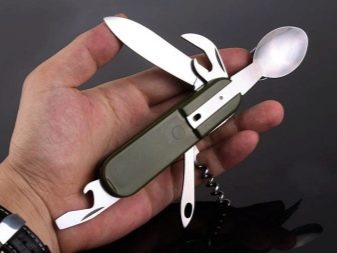

Features
The appearance of devices for opening cans is due to the beginning of the use of tinned tin for their manufacture. The material has become thinner and relatively soft. To open such a jar became possible even with an ordinary knife. But this method, although low cost, remains the most dangerous. The knife can slip off the surface of the can and then the consequences can be, to put it mildly, unpleasant. No less dangerous is the edge of the formed slice. Make it neat does not work, torn and jagged edges randomly bending, will pose a rather serious danger.
The main elements of a special canned knife were a thick short blade that is difficult to break and a special stop for the edge of the can so that the appliance does not slip. This made it possible to obtain smoother cut edges and make the can opening process safer. The development of the idea led to the creation of the safest species, generally devoid of a blade as such. Its function began to perform spinning pointed wheels, contact of which with the hands of a person opening a can is practically impossible.
All that remained was to improve the process, automating it more and more.

Kinds
The development of devices for opening cans has led to the emergence of the most diverse, often completely dissimilar designs.
The easiest way is the built-in key, which is available for cans made specially with this simple device. The lids of such cans have a special groove along the flange. If you pull the key evenly, the can opens, while the edge formed, despite the thinness of the tin in this place, is quite safe, however, it will no longer be possible to use the curved can lid.
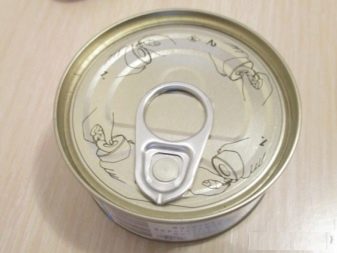

Another option for the built-in key involves screwing the lid into a roll, as a result of which the contents of the can become accessible. The method received the widest distribution in the first half of the XX century. In both cases, the production of cans requires some complication of their design. The undeniable advantage of the described keys is their reliability in the field, when it is difficult to maintain a special autonomous opener. For this reason, such banks with keys began to make army rations.

In the conditions of expeditions, and ordinary hiking, it is much easier to ensure the safety of tools. A modern folding knife with a set of blades and tools almost always includes the simplest opener for cans.

Special developments for housewives led to the appearance of openers with various technical solutions that reduce the physical effort when opening the can. One of the main directions has become development of an opener with a clamping mechanism and a rotary handle connected to a cutting wheel. There are several options for this device. The most important difference is the minimum force applied to the opening process. A mechanical opener neatly cuts the can either along the side or immediately below it.

The advent of electric openers has become a natural development of mechanical models.in which, one way or another, human efforts were still required. Even portable electric devices with batteries carry out all mechanical operations on their own. An automatic electric opener eliminated the need to hold a can. You just need to insert it into the device, and at the end of the operation, remove it.
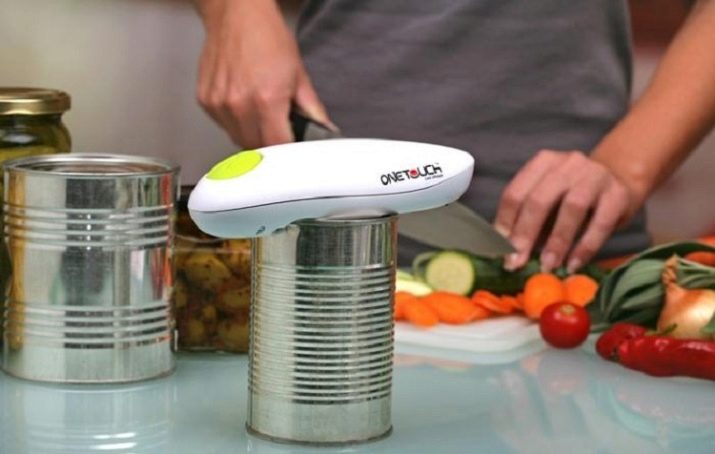
Among the modern kitchen tools, you can find quite massive and from this steady table openers. These electrical appliances are made of sufficiently strong materials, which allows for their long-term operation. A tabletop opener is installed on rubberized legs, which prevents slipping. The can is fixed in a special holder and, turning, is automatically cut along the edge with a sharp stainless steel knife.
Many desktop models are equipped with a holder with a magnet, its task is not only to securely fix the jar, but also to hold the lid after the jar is opened.

In bars, restaurants and cafes, the so-called professional opener of large dimensions and power is often used to open large tin cans. It differs from household appliances in the ability to open cans with a weight exceeding 1.2 kg. Increased requirements for strength, stability and performance of such devices affect their price. This is perhaps the most expensive, but at the same time universal option of the device for opening any cans.

Rating of the best models
By purchasing an opener for cans, of course, each determines its choice according to the mandatory requirements of the goods. Among them:
- functionality;
- durability;
- price
However, the feedback of the owners of a particular model of the device is no less important.

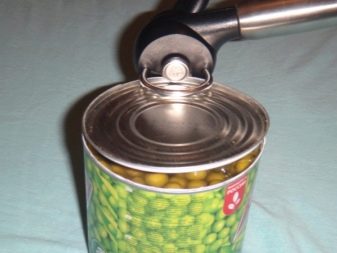
Currently, the market is literally saturated with low-cost Chinese-made mechanical openers. Products from different manufacturers are one and the same very well-established model of a mechanical opener, developed back in the middle of the 20th century by Tefal specialists. The opener allows you to get a smooth edge without sharp edges and burrs. The price of the Chinese version is much lower than the price of the original.


The Chinese industry has also mastered the production of the popular model of the Soviet openers for cans and bottles, with a convenient wooden handle, under the name "Retro".
Of course, quality goods are provided by companies that have proven themselves in the production of kitchen equipment. The widest range of mechanical openers, and even simple can openers, is produced by the companies: Tefal, Metaltex, Tescoma, Bradantia.
- The review of electric models will begin with the original Openers "Moment". The name speaks for itself. Indeed, this device copes with its work quickly. In addition, the edge of the cut is smooth and completely safe. The “Moment” electric can opener is powered by two AA batteries. The device easily adapts to any standard size of covers.

- Original Polaris PJO 3003 - A small electric device, mounted on a can, placed on a table or other flat surface. After starting, the machine opens the can and stops at the end of the process. It remains only to remove the opener from the can. The user does not require absolutely no effort to open canned food.

- Great desktop opener option offers company tefal, its model Tefal 8536 is an example of a classic reliable device in its class. This versatile kitchen appliance equally opens both tin cans and bottles. It will help when sharpening kitchen knives. The can is fixed using a magnet. The opener starts from a light touch on a special lever. The unit is absolutely safe for the user.

- A similar device and no less reliability have a number of models from other manufacturers: Kenwood CO 600, CASO (D 10), Tristar (BO 2102). The design solution distinguishes them from each other, including variants of models in a metal case and with different power drives, which, of course, affects the price of the goods. Compared to the Tefal opener described, modifications to some models can be up to three times more expensive.

- Serious equipment is required for the normal functioning of a modern restaurant. So, for daily intensive use, a number of companies offer professional units. Cancan Turkish Opener - one of such devices. This rather dimensional stationary device is intended for opening cans up to 350 mm high. You can open up to 8 cans per minute with this appliance.
Different models are designed to open round and square tin cans.


How to choose?
The choice of model of openers for cans can be dictated by the requirements for this device. So, in traveling or country conditions it will be possible to do with the simplest optionrequiring quite considerable physical effort, a portable electric opener is suitable for such conditions. For housewives, as the most budget option, simple mechanical models are suitable. If you have to open cans quite a lot and often, it is better to purchase electric models of openers. In any case, the owners of a cafe or restaurant will have to consider acquiring a professional device.

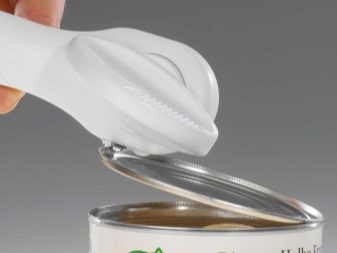
The variety of modern devices for opening cans is very large.
A high-quality opener should comply with a number of simple requirements, including:
- reliability;
- convenience;
- security.
For kitchen units, in addition to functionality, design can be an important criterion.


Terms of use
Devices for opening cans are far from the same, it is the variety of technical solutions that often causes their improper use, which in turn causes injury or other unpleasant consequences.
As a rule, instructions are attached to modern electronic devices, following which will avoid troubles.

Oddly enough, it is precisely the inability to use the simplest openers that most often causes injuries, scratches or cuts. To use them safely, you need to follow a few simple rules:
- open the jar on a hard surface, fixing it with your hand;
- performing opening operations, try not to be distracted, controlling the entire process;
- After using the opener is finished, carefully open and remove the cover, paying attention to its edges.




An overview of the One touch can openers in the video below.










